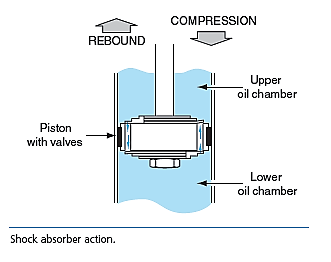Shock Absorber Operation
Introduction:
Shock absorbers are installed on suspension systems to control spring action. When a wheel strikes a bump and jounce travel occurs, the shock absorber lower tube unit is forced upward.
Shock absorber action
- Shock absorbers are usually mounted between the lower control arms and the chassis. When a vehicle wheel strikes a bump, the wheel and suspension move upward in relation to the chassis. Upward wheel movement is referred to as jounce travel.
- This jounce action causes the spring to deflect or compress. Under this condition, the spring stores energy and springs back downward with all the energy absorbed when it deflected upward. This downward spring and wheel action is called rebound travel.
- If this spring action were not controlled, the wheel would strike the road with a strong downward force, and the wheel jounce would occur again. Therefore, some device must be installed to control the spring action, or the wheel would bounce up and down many times after it hit a bump, causing passenger discomfort, directional instability, and suspension component wear.
- When the spring expands downward in rebound travel, the lower shock absorber unit is also forced downward. When this occurs, the piston moves upward in the lower tube unit, and hydraulic oil is forced through the piston valves from the upper oil chamber to the lower oil chamber.
- Since the valves restrict oil flow with precise control, the downward suspension and wheel movement is controlled.
- When the shock absorber piston moves, oil is forced through the piston. Since the piston valves and orifices resist the flow of oil, friction and heat are created.

The resistance of the oil moving through the piston must be calibrated as closely as possible to the spring’s deflection rate or strength. Wheels and suspension systems deflect at many different speeds, depending on the type and size of bump and the vehicle speed. The resistance of a shock absorber piston increases with the square of its speed. For example, if the wheel deflection speed increases four times, the piston resistance is sixteen times as great. Therefore, if a wheel strikes a large bump at high speed, the wheel deflection and rebound can be effectively locked by the shock absorber. Shock absorber engineers prevent this action by precisely designing shock absorber valves and orifices to provide enough friction to prevent the spring from overextending on the rebound stroke. These piston valves and orifices must not create excessive friction, which slows the wheel from returning to its original position.
- Shock absorber pistons have many different types of valves and orifices. In some pistons, small orifices control the oil flow during slow wheel and suspension movements.
- Stacked steel valves control the oil flow during medium speed wheel and suspension movements. During maximum wheel and suspension movements, larger orifices between the piston valves provide oil flow control. On other shock absorber pistons, the stacked steel valves alone provide oil flow control.
- Regardless of the piston orifice and valve design, the shock absorber must be precisely matched to absorb the spring’s energy.
- During fast upward wheel movement on the compression stroke, excessive pressure in the lower oil chamber forces the base valve open and thus allows oil to flow through this valve to the reservoir.
- The nitrogen gas provides a compensating space for the oil that is displaced into the reservoir on the compression stroke and when the oil is heated. Since the gas exerts pressure on the oil, cavitation, or foaming of the oil, is eliminated.
- When oil bubbles are eliminated in this way, the shock absorber provides continuous damping for wheel deflections as small as 0.078 in (2.0 mm).
- A rebound rubber is located on top of the piston. If the wheel drops downward into a hole, the shock absorber may become fully extended. Under this condition, the rebound rubber provides a cushioning action.